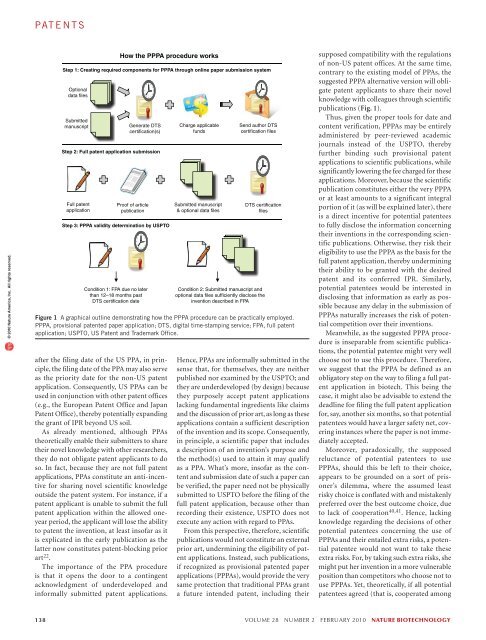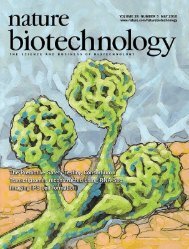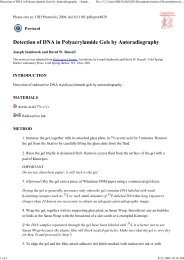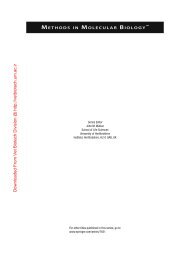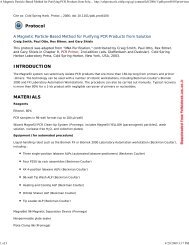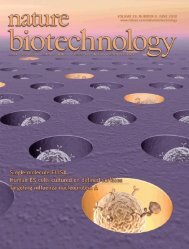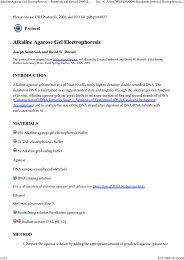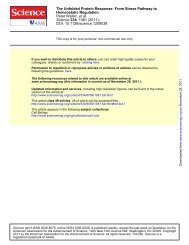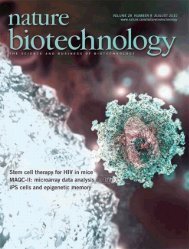patents© 2010 Nature America, Inc. All rights reserved.How the PPPA procedure worksStep 1: Creating required components for PPPA through online paper submission systemOptionaldata filesSubmittedmanuscriptGenerate DTScertification(s)Step 2: Full patent application submissionFull patentapplicationProof of articlepublicationStep 3: PPPA validity determination by USPTOCondition 1: FPA due no laterthan 12–18 months pastDTS certification dateafter the filing date of the US PPA, in principle,the filing date of the PPA may also serveas the priority date for the non-US patentapplication. Consequently, US PPAs can beused in conjunction with other patent offices(e.g., the European Patent Office and JapanPatent Office), thereby potentially expandingthe grant of IPR beyond US soil.As already mentioned, although PPAstheoretically enable their submitters to sharetheir novel knowledge with other researchers,they do not obligate patent applicants to doso. In fact, because they are not full patentapplications, PPAs constitute an anti-incentivefor sharing novel scientific knowledgeoutside the patent system. For instance, if apatent applicant is unable to submit the fullpatent application within the allowed oneyearperiod, the applicant will lose the abilityto patent the invention, at least insofar as itis explicated in the early publication as thelatter now constitutes patent-blocking priorart 22 .The importance of the PPA procedureis that it opens the door to a contingentacknowledgment of underdeveloped andinformally submitted patent applications.Charge applicablefundsSubmitted manuscript& optional data filesSend author DTScertification filesDTS certificationfilesCondition 2: Submitted manuscript andoptional data files sufficiently disclose theinvention described in FPAFigure 1 A graphical outline demonstrating how the PPPA procedure can be practically employed.PPPA, provisional patented paper application; DTS, digital time-stamping service; FPA, full patentapplication; USPTO, US Patent and Trademark Office.Hence, PPAs are informally submitted in thesense that, for themselves, they are neitherpublished nor examined by the USPTO; andthey are underdeveloped (by design) becausethey purposely accept patent applicationslacking fundamental ingredients like claimsand the discussion of prior art, as long as theseapplications contain a sufficient descriptionof the invention and its scope. Consequently,in principle, a scientific paper that includesa description of an invention’s purpose andthe method(s) used to attain it may qualifyas a PPA. What’s more, insofar as the contentand submission date of such a paper canbe verified, the paper need not be physicallysubmitted to USPTO before the filing of thefull patent application, because other thanrecording their existence, USPTO does notexecute any action with regard to PPAs.From this perspective, therefore, scientificpublications would not constitute an externalprior art, undermining the eligibility of patentapplications. Instead, such publications,if recognized as provisional patented paperapplications (PPPAs), would provide the verysame protection that traditional PPAs granta future intended patent, including theirsupposed compatibility with the regulationsof non-US patent offices. At the same time,contrary to the existing model of PPAs, thesuggested PPPA alternative version will obligatepatent applicants to share their novelknowledge with colleagues through scientificpublications (Fig. 1).Thus, given the proper tools for date andcontent verification, PPPAs may be entirelyadministered by peer-reviewed academicjournals instead of the USPTO, therebyfurther binding such provisional patentapplications to scientific publications, whilesignificantly lowering the fee charged for theseapplications. Moreover, because the scientificpublication constitutes either the very PPPAor at least amounts to a significant integralportion of it (as will be explained later), thereis a direct incentive for potential patenteesto fully disclose the information concerningtheir inventions in the corresponding scientificpublications. Otherwise, they risk theireligibility to use the PPPA as the basis for thefull patent application, thereby underminingtheir ability to be granted with the desiredpatent and its conferred IPR. Similarly,potential patentees would be interested indisclosing that information as early as possiblebecause any delay in the submission ofPPPAs naturally increases the risk of potentialcompetition over their inventions.Meanwhile, as the suggested PPPA procedureis inseparable from scientific publications,the potential patentee might very wellchoose not to use this procedure. Therefore,we suggest that the PPPA be defined as anobligatory step on the way to filing a full patentapplication in biotech. This being thecase, it might also be advisable to extend thedeadline for filing the full patent applicationfor, say, another six months, so that potentialpatentees would have a larger safety net, coveringinstances where the paper is not immediatelyaccepted.Moreover, paradoxically, the supposedreluctance of potential patentees to usePPPAs, should this be left to their choice,appears to be grounded on a sort of prisoner’sdilemma, where the assumed leastrisky choice is conflated with and mistakenlypreferred over the best outcome choice, dueto lack of cooperation 40,41 . Hence, lackingknowledge regarding the decisions of otherpotential patentees concerning the use ofPPPAs and their entailed extra risks, a potentialpatentee would not want to take theseextra risks. For, by taking such extra risks, shemight put her invention in a more vulnerableposition than competitors who choose not touse PPPAs. Yet, theoretically, if all potentialpatentees agreed (that is, cooperated among138 volume 28 number 2 february 2010 nature biotechnology
patents© 2010 Nature America, Inc. All rights reserved.themselves) to use PPPAs before their fullpatent applications were submitted, such anagreement would result in a much better outcomefor all involved parties.By reaching this agreement, all PPPAsubmitters would be granted the followingbenefits:1. Elimination of the extra risks associatedwith PPPAs, as the latter will entail nowmerely standard risks shared by all potentialpatentees.2. Preliminary professional assessments of theinvention’s validity through the journal’speer-review process, thereby indicatingwhether the invention is worth investing in.3. An earlier ‘certificate of quality’, should thescientific paper describing the invention beaccepted, thereby potentially increasing theability to raise more funds.4. Possible advice for prepatenting improvementsto the invention, leading to a potentialincrease in the patent’s value.Mandatory PPPAs are, therefore, justifiable,even from the viewpoint of potentialpatentees, while being an acceptable form ofprovisional patent application (PPA). At thesame time, PPPAs address the first portionof the secrecy threat, regarding the possiblereluctance of potential patentees to publiclyshare new scientific knowledge in a full andeasily accessible manner.From theory to practiceAssuming the employment of mandatoryPPPAs is logically plausible, even from apotential patentee’s standpoint, it is still necessaryto explain whether and how they canbe applied in practice. Essentially, enablingvalid and effective PPPAs necessitates thatscientific publications provide papers’ submitterswith trustworthy certifications of thedate and content of the relevant informationthat is needed to constitute such PPPAs. Thatway, though PPPAs are not administered bya patent office, but rather by academic journals,PPPAs would be amply reliable for useby both potential patentees and the USPTO.Accordingly, to supply such trustworthy certifications,academic journals must complywith the following three requirements:1. Provide authors, upon their request, withthe necessary certification of the papersubmitted for publication that describesthe invention for which a patent may besought.2. Grant authors, upon their request, a separatecertification for additional optionaland unpublished data that they wish toinclude as part of the PPPA. Such certifiedbut unpublished data contain materialsthat are not suitable for a scientific paper,but might be technically important forsecuring the full patent application (e.g.,certain claims or additional figures).3. Ensure that the granted certifications canbe independently verified by the USPTOin a simple manner, once full patent applicationsare submitted. That is, allow theUSPTO to (i) check the authenticity ofthese certifications and (ii) ensure that,insofar as the content of the certifiedmanuscript is concerned, it is adequatelycovered by the finalized published paper.All of the aforementioned requirementscan be realized by a combination of two existingand widely accessible technologies. Onetechnology is the digital time-stamping service,issuing a trusted third-party time-stampthat associates a date and time with a digitaldocument in a cryptographically strong way.The digital time-stamp can be used at a laterdate (e.g., by USPTO) to independently verifythat an electronic document with a particularcontent existed at the time stated on its timestamp,thereby certifying the document’s contentand creation date 42,43 . In this respect, it isimportant to note two points. First, a digitaltime-stamp, understood as a specific type ofdigital signature 44 , is legally supported andrecognized by applicable legislations in manycountries worldwide, and specifically by theUnited States 45 . Second, commercial digitaltime-stamping services 46 are already availableon the Internet with costs as low as 40 centsper use, making the financial barriers negligibleto end-users.The other technology is the widelyemployed online paper submission processingsoftware (e.g., Editorial Manager, ManuscriptCentral) already used, according to a recentstudy, by 76% of the peer-reviewed academicjournals, and still growing 47 . The significanceof these web-based computer programs istwofold. First, they can provide the optionof date and content certification within thepaper submission process, through seamlesslyembedding the already available digitaltime-stamping toolkits that were designed tobe set-in within a third-party software environment.Second, these programs include abundle of features like financial transactionand automatic e-mail communication withthe submitters of papers 48 . As such, thesefeatures provide further necessary supportfor employing PPPAs, like the ability to sendauthors their needed certified documents andtheir finalized articles’ proofs, as well as collectingthe applicable fees for USPTO and thedigital time-stamping service.PPPAs limit the effects of the tragedy ofthe anticommonsOnce used, PPPAs can also provide an adequatetheoretical justification, from a patents’advocate viewpoint, for significantly limitingthe negative effects of the tragedy of theanticommons. This theoretical rationalizationis based on patentees’ interest in securingthe main benefit that is gained by theirpatents, namely IPR, as patents effectivelygrant patentees exclusive property rights overtheir inventions, even if for a limited periodof time. The original notion of exclusiveproperty rights and its justification is usuallyattributed to John Locke, the forefatherof classical liberalism, though he simply usedthe term ‘property rights’ 49 . In fact, Locke’sframing of property rights is still influentialamong contemporary libertarians and neoliberals,who usually perceive themselves ashis successors, and therefore Locke’s thoughtis still relevant for contemporary discussionsof exclusive property rights 50–52 .According to Locke, the initial justificationfor private exclusive property rights stemsfrom an individual’s “mixing of his labor” ina previously unowned object. Thus, an individual,naturally, has exclusive ownershiprights over his own labor, namely, it is hisproperty. Consequently, by mixing his labor,it becomes inextricably part of the object,thereby rendering anyone else who wouldthen use that object as effectively infringingthe property that the first person has‘invested’ in the object through his labor. Byannexing her labor to the object, therefore,the individual restricts others’ right to use it,making it exclusively her own 49,53 .Acquiring a previously unowned object,then, necessitates that the new owner bethe sole investor of labor in this object (beit directly from his own work, or indirectlythrough transfer of other people’s labor tohis disposal). Inversely put, so long as otherpeople have invested their direct or indirectlabor in the object at hand as well, withoutbeing compensated for their loss of proportionateinvestment, no one can claim exclusiveproperty rights over the object.From this perspective, therefore, a patent,pertaining per se to a new invention, involvesan ownership of a previously unowned object,and may be granted to the patent applicantonly if at the time the patent was granted,the applicant (and his party) could benature biotechnology volume 28 number 2 february 2010 139
- Page 3 and 4: volume 28 number 2 february 2010COM
- Page 5 and 6: in this issue© 2010 Nature America
- Page 7 and 8: © 2010 Nature America, Inc. All ri
- Page 10 and 11: NEWS© 2010 Nature America, Inc. Al
- Page 12 and 13: NEWS© 2010 Nature America, Inc. Al
- Page 14 and 15: NEWS© 2010 Nature America, Inc. Al
- Page 16 and 17: © 2010 Nature America, Inc. All ri
- Page 18 and 19: © 2010 Nature America, Inc. All ri
- Page 20 and 21: © 2010 Nature America, Inc. All ri
- Page 22 and 23: NEWS feature© 2010 Nature America,
- Page 24 and 25: uilding a businessComing to termsDa
- Page 26 and 27: uilding a business© 2010 Nature Am
- Page 28 and 29: correspondence© 2010 Nature Americ
- Page 30 and 31: correspondence© 2010 Nature Americ
- Page 32 and 33: correspondence© 2010 Nature Americ
- Page 34 and 35: correspondence© 2010 Nature Americ
- Page 36 and 37: case studyNever againcommentaryChri
- Page 38 and 39: COMMENTARY© 2010 Nature America, I
- Page 40 and 41: COMMENTARY© 2010 Nature America, I
- Page 44 and 45: patents© 2010 Nature America, Inc.
- Page 46 and 47: news and viewsChIPs and regulatory
- Page 48 and 49: news and viewsFrom genomics to crop
- Page 50 and 51: news and views© 2010 Nature Americ
- Page 52 and 53: news and views© 2010 Nature Americ
- Page 54 and 55: e s o u r c eRational association o
- Page 56 and 57: e s o u r c e© 2010 Nature America
- Page 58 and 59: e s o u r c e© 2010 Nature America
- Page 60 and 61: e s o u r c e© 2010 Nature America
- Page 62 and 63: © 2010 Nature America, Inc. All ri
- Page 64 and 65: B r i e f c o m m u n i c at i o n
- Page 66 and 67: i e f c o m m u n i c at i o n sAUT
- Page 68 and 69: lettersa1.5 kb hVPrIntron 112.5 kbA
- Page 70 and 71: letters© 2010 Nature America, Inc.
- Page 72 and 73: letters© 2010 Nature America, Inc.
- Page 74 and 75: l e t t e r sReal-time imaging of h
- Page 76 and 77: l e t t e r sFigure 2 Time-lapse li
- Page 78 and 79: l e t t e r s© 2010 Nature America
- Page 80 and 81: l e t t e r sRational design of cat
- Page 82 and 83: l e t t e r s© 2010 Nature America
- Page 84 and 85: l e t t e r s© 2010 Nature America
- Page 86 and 87: sample fluorescence was measured as
- Page 88 and 89: careers and recruitmentFourth quart


